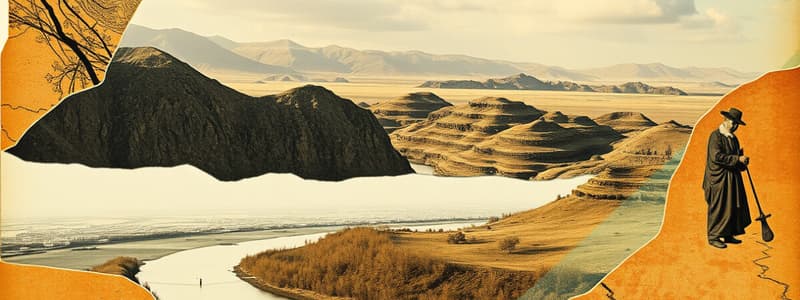Podcast
Questions and Answers
What is a cultural landscape?
What is a cultural landscape?
Combinations of physical features, agricultural and industrial practices, religious and linguistic characteristics, evidence of sequent occupancy, and other expressions of culture including traditional and postmodern architecture and land-use patterns.
What are features of cultural landscapes?
What are features of cultural landscapes?
Place names, architectural styles
What does land set aside from development in national parks reflect?
What does land set aside from development in national parks reflect?
- Urbanization
- Economic growth
- Cultural homogenization
- Desire to preserve unique environments (correct)
Signage in Quebec is only in English.
Signage in Quebec is only in English.
How do gender-segregated schools reflect attitudes in Pakistan?
How do gender-segregated schools reflect attitudes in Pakistan?
What do massive skyscrapers in Shanghai reflect?
What do massive skyscrapers in Shanghai reflect?
What are ethnic enclaves?
What are ethnic enclaves?
What are common features of ethnic enclaves?
What are common features of ethnic enclaves?
What causes ethnic enclaves?
What causes ethnic enclaves?
What are borders and barriers in cultural contexts?
What are borders and barriers in cultural contexts?
Give an example of a border and barrier.
Give an example of a border and barrier.
What are cultural realms?
What are cultural realms?
Match the following religions with their corresponding characteristics:
Match the following religions with their corresponding characteristics:
What are examples of religion and physical landscape?
What are examples of religion and physical landscape?
What memorial spaces are common in religious contexts?
What memorial spaces are common in religious contexts?
What architectural feature commonly indicates Christianity?
What architectural feature commonly indicates Christianity?
What are gender roles in contemporary society?
What are gender roles in contemporary society?
Flashcards
Cultural Landscape
Cultural Landscape
The interaction of physical features, agricultural practices, religious characteristics, and cultural expressions.
National Parks
National Parks
Areas designated to preserve unique environmental characteristics and biodiversity.
Ethnic Enclave
Ethnic Enclave
A cultural group surrounded by a dominant culture, fostering a distinct cultural community.
Borders and Barriers
Borders and Barriers
Signup and view all the flashcards
Cultural Realms
Cultural Realms
Signup and view all the flashcards
Religion and Physical Landscape
Religion and Physical Landscape
Signup and view all the flashcards
Christian Architecture
Christian Architecture
Signup and view all the flashcards
Hindu Architecture
Hindu Architecture
Signup and view all the flashcards
Buddhist Architecture
Buddhist Architecture
Signup and view all the flashcards
Islamic Architecture
Islamic Architecture
Signup and view all the flashcards
Shinto Practices
Shinto Practices
Signup and view all the flashcards
Gender-segregated Schools
Gender-segregated Schools
Signup and view all the flashcards
Office Buildings
Office Buildings
Signup and view all the flashcards
Elements of Ethnic Enclaves
Elements of Ethnic Enclaves
Signup and view all the flashcards
Causes of Ethnic Enclaves
Causes of Ethnic Enclaves
Signup and view all the flashcards
Changing Gender Roles
Changing Gender Roles
Signup and view all the flashcards
Bilingual Signs
Bilingual Signs
Signup and view all the flashcards
Study Notes
Cultural Landscape
- Represents the interaction of physical features, agricultural practices, religious characteristics, and cultural expressions.
- Includes traditional and postmodern architecture, as well as land-use patterns.
Features of Cultural Landscapes
- Influenced by place names, such as Spanish names in California or "Saint" names in various cities.
- Architectural styles play a significant role in reflecting cultural identity.
National Parks in the United States
- Designated areas that aim to preserve unique environmental characteristics and biodiversity.
Signage in Quebec
- Bilingual signs in French and English showcase the commitment of French Canadians to maintaining their cultural heritage.
Gender-segregated Schools in Pakistan
- Reflects traditional attitudes towards gender roles within society.
Office Buildings in Shanghai
- Structures symbolize economic power and the importance of centralizing business operations in recognizable locations.
Ethnic Enclaves
- Comprised of cultural groups surrounded by a dominant culture, fostering a distinct cultural community.
Elements of Ethnic Enclaves
- Include residences, stores, religious institutions, characteristic signage, and architecture reflecting the group's cultural roots.
Causes of Ethnic Enclaves
- Often result from the dominant culture's desire to segregate or the minority culture seeking a buffer against discrimination.
Borders and Barriers
- Represent transition zones between different cultures, serving as boundaries that define cultural interaction.
Examples of Borders and Barriers
- The US-Mexico border, particularly in areas like El Paso, Texas, where bilingualism thrives.
Cultural Realms
- Broad cultural areas comprising several regions sharing key attributes such as language families, religions, food preferences, architecture, and historical experiences.
Religion and Physical Landscape
- Spiritual beliefs lead to reverence for natural features, such as mountains and rivers, considered sacred in various religions (e.g., Shinto, Judaism, Islam).
Religion and Cultural Landscape
- Cultural expressions such as cemeteries near places of worship and markets selling religiously approved food underpin community identities.
Christianity's Architectural Influence
- Churches often feature tall steeples and unique roof designs adapted to local climates.
- Cemeteries vary in structure, with some regions (e.g., New Orleans) utilizing above-ground graves.
Hinduism's Architectural Significance
- Temples showcase detailed carvings and are often situated near rivers for sacred rituals.
- Cremation practices highlight the belief in purification through water, particularly the Ganges River.
Buddhism's Connection to Nature
- Stupas symbolize natural elements and serve as meditation sites, promoting harmony with the environment.
Judaism's Global Distribution
- Communities evolved due to historical exiles and migrations, leading to diverse temple sizes and burial customs emphasizing timely interment.
Islam's Architectural Elements
- Mosques, usually centrally located with prominent domes and minarets, are key community structures that prioritize congregational worship and prompt burial practices.
Shinto Practices in Japan
- Emphasizes a connection with nature and ancestry, often marked by torii gates leading to sacred spaces.
Changing Gender Roles
- Women's roles have evolved, with diminishing strict gender roles and increasing opportunities for property ownership and leadership in developed regions.
- Historically, men experienced greater freedom in public life compared to women.
Studying That Suits You
Use AI to generate personalized quizzes and flashcards to suit your learning preferences.




